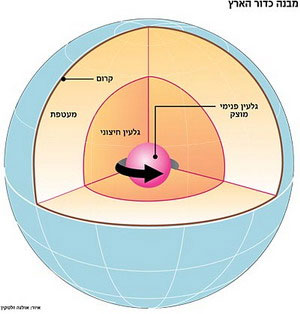New research shows that the inner core of KDHA completes a rotation around its axis faster than the rest of the star. The reason - interaction between electric currents
Kenneth Chang, Haaretz, Walla News!

In 1996, two geophysicists from the Lamont-Doherty Earth Research Laboratory at Columbia University hypothesized that the Earth's inner core rotates around its axis at a faster rate than the rest of the Earth. Now the two presented a new study in the journal "Science", confirming their hypothesis. According to them, for a period of between 700 and 1,200 years, the inner core is enough to make another full rotation.
The inner core is a ball of solid iron with a diameter of about 2,400 kilometers, and it is wrapped in an outer core with a diameter of about 7,000 kilometers and which consists of hot liquid metal. Since there is nothing fixing the inner core, two geophysicists argued about a decade ago, it can move freely and faster than the rest of the star.
But other scientists questioned their analysis, which was based on comparing the speed of movement of earthquake waves that passed through the Earth. Other attempts to determine the rotation speed of the inner core have produced a variety of results. Some scientists claimed that it does rotate, but at a slower rate than the one determined by the researchers from Colombia. Others said they could find no signs that the inner core was not moving at the same rate as the rest of the Earth.
The researchers from Columbia - Dr. Paul Richards and Dr. Xiaodong Song, currently a geologist at the University of Illinois - have conducted a new study, which they say will eliminate all doubts. Dr. Gary Glatzmeier, a professor of earth sciences at the University of California, Santa Cruz, who was not involved in the new research, said that "now, those who look at the data will say 'That's right, the inner core is obviously rotating faster than the rest of the Earth.'"
The friction between the outer and inner core creates electric currents
In a study they conducted in 1996, Richards and Song compared seismic signals from earthquakes in different regions of the Earth, and concluded that the inner core rotates at a fast rate of 1.1 degrees per year compared to the rest of the planet. The new study is more accurate, as the researchers were able to locate 18 pairs of earthquakes that occurred years apart, but were nearly identical in terms of strength and location. The earthquakes occurred in the Sandwich Islands region of the South Atlantic Ocean, near Antarctica, and were picked up by seismographs in Alaska. On their way from pole to pole, the seismic waves spread through the Earth. Some passed through the inner core and some did not.
"The waves that traveled through the region outside the inner core - the Earth's crust, the mantle, the outer core - are all the same," Song said. "Only when they pass through the inner core are they different."
The researchers discovered two main differences between the seismic waves that passed through the inner core and those that did not. First, the waves that passed through the inner core moved faster. For example, in an earthquake that occurred in 2003, the seismic waves that traveled through the inner core reached Alaska a tenth of a second faster, compared to waves from an almost identical event in 1993, where the seismic waves did not travel through the inner core. In addition, the seismic waves that pass through the inner core change their shape. "From these observations we conclude that the changes are caused by the inner core, and the reason for the changes is that it rotates faster than the rest of the Earth," Song said.
AdvertisementResearchers believe that the frictional forces between the outer core and the inner core create electric currents, which in turn generate the Earth's magnetic field. According to Richards and Song, it is the interaction between the electric currents and the magnetic field that causes the inner core to rotate at a greater angular velocity compared to the rest of the star. The Earth completes one revolution around its axis (360 degrees) a day. The new research shows that over the course of a year, the inner core rotates an additional 0.3 to 0.5 degrees, compared to the rest of the Earth.
Glatzmeier said Richards and Song's findings are "very important" to understanding the Earth's magnetic field.

One response
Hello, I wanted to know if the fast rotation of the core affects the speed of rotation of the northern and southern ends of the ball? (If not, I would love to know what it is and an answer by email)
Thank you!